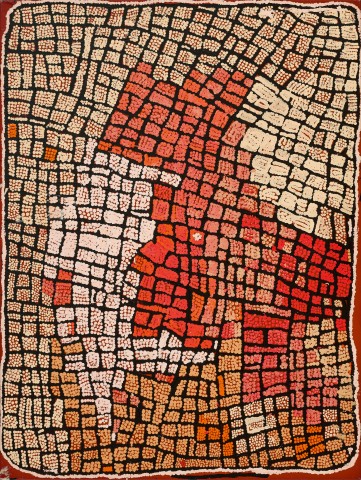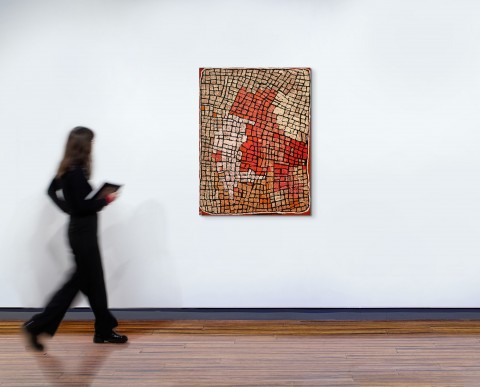MARRAPINTI, 2004
NAATA NUNGURRAYI
synthetic polymer paint on linen
122.0 x 91.5 cm
bears inscription verso: artist’s name, size and Papunya Tula Artists cat. NN0409127
Papunya Tula Artists, Alice Springs, Northern Territory
Tony Bond, Adelaide
Private collection, Adelaide
Born around 1932, senior Pintupi artist Naata Nungurrayi is celebrated for works which act as visual manifestations of her lived experience and intangible cultural knowledge. As the artist describes: ‘I am painting my home, my Country — women’s Kanaputa story. Travelling along Irrututu, Tjuntupul, Marrapinti, Ngami, Wirrul. A long time ago, I travelled all around this Country, from place to place.’1 Across her practice, Nungurrayi visually translated facets of the geographies and topographies of culturally significant sites and designs associated with Kungka (Women) Dreaming – specifically her home of Marrapinti, a sacred waterhole located to the west of Pollock Hills, Western Australia, where a group of travelling ancestral women stopped and made nose-bones (known as marrapinti), to be worn in the context of ceremonial occasions by older generations of Pintupi.
Painted in warm hues, the vibrantly coloured composition, Marrapinti, 2004, reflects the way Nungurrayi painted with a ‘singled-minded, trance like’ focus, and ‘an intensity that matches the colours at play in her work’.2 In this work, the densely layered and modulated fields of warm dotted colour, overlaid with bold gestural lines, typify Nungurrayi’s mastery in rendering the depth and intangible energy of country, with these interconnecting lines representing the living presence of the tali (sandhills) of her Country. As Luke Scholes articulates, ‘Naata is one of Papunya Tula Artists’ most celebrated painters. A quintessential Pintupi eccentric, briming with life and a rare, painterly gift.’3
1. Nungurrayi, cited in unDisclosed: 2nd National Indigenous Art Triennial, National Gallery of Australia, Canberra, 2012, p. 99
2. Perkins, H., Art+Soul, The Miegunyah Press, Melbourne, 2010, p. 26
3. Scholes, L., Beyond Sacred: Australian Aboriginal Art: The Collection of Colin and Elizabeth Laverty, Edition II, Kleimeyer Industries Pty Ltd, Melbourne, 2011, p. 58
GEORGIE LATHAM

